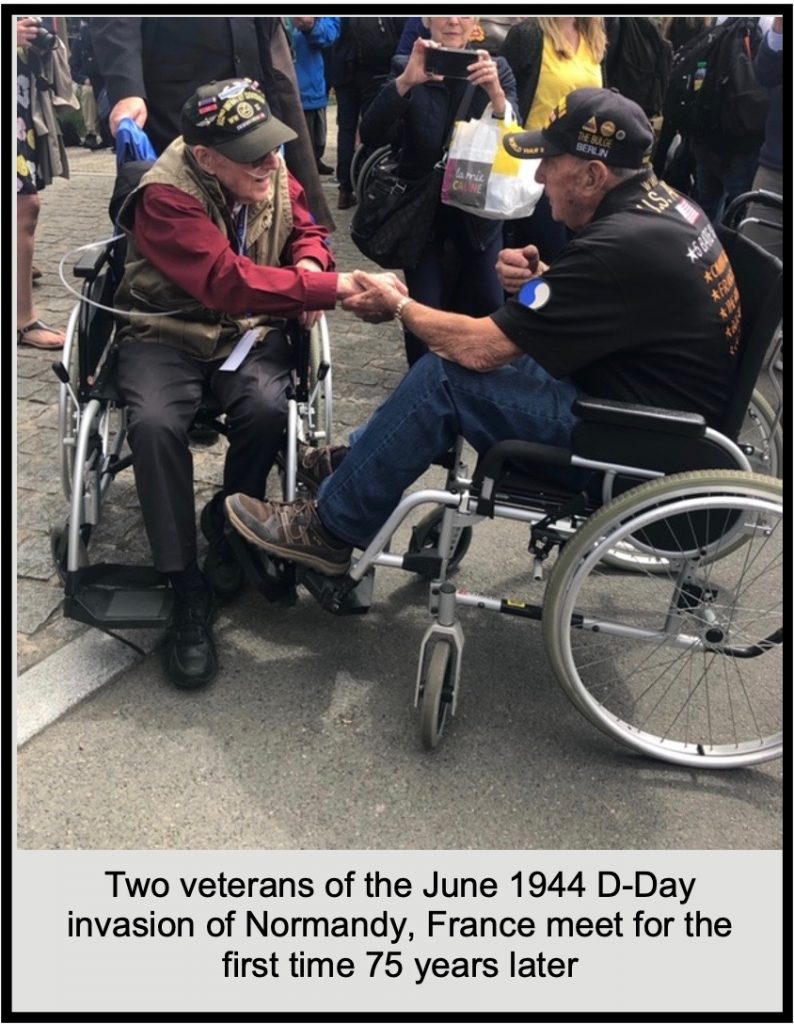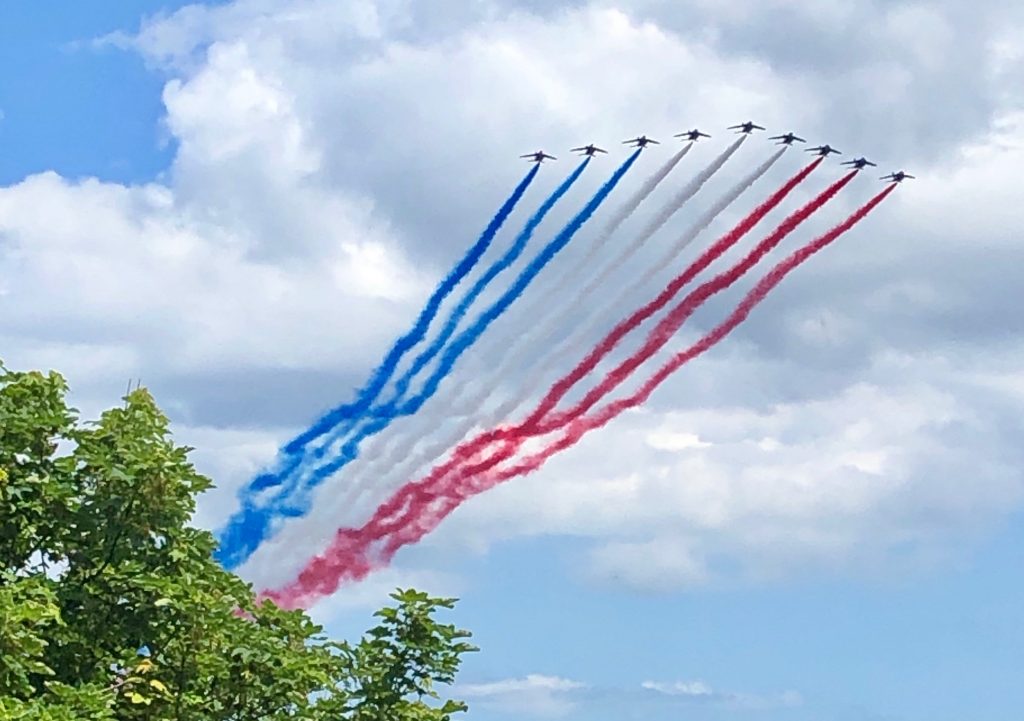World War ll – The Western Front
It is June 1944. The United States is in its third year as a combatant in the Second World War. Nazi Germany controls much of Continental Europe. For three years the Soviet Union has been engaged in a violent battle with Germany in the east. It is pressing its allies, the United States and Great Britain, to open a second front in the west.
Anticipating such an attack, the Nazis build an extensive and massive system of coastal defenses and fortifications. This “Atlantic Wall” stretches from Scandinavia in the north to the French border with Spain in the south. Concrete bunkers buried deeply underground, huge coastal guns, batteries, artillery and thousands of German troops dominate the land mass. Mines and anti-tank barriers lay hidden in the waters approaching the coast. All create a formidable obstacle to an invasion of Nazi held territory from the west.
The D-Day Invasion Force
The allies assemble an invasion force in southern England with the naval vessels to transport it across the English Channel. It includes thousands of troops, tanks, vehicles, landing craft and other instruments of war. They name the operation “Overlord.”
The Supreme Commander of the allied forces, General Dwight D. Eisenhower, selects June 5, 1944, as the date for the invasion. However, his meteorologist predicts bad weather on that day and Eisenhower delays the launch. On June 5th his meteorologist predicts clearing over the Channel on June 6th. Eisenhower gives the order to “go” on the 6th.
It is the evening of June 5th. Infantrymen already on board anxiously await their ship’s departure across the Channel. Apprehensive paratroopers stand ready to board planes to be dropped behind enemy lines before dawn June 6th. Most men about to do battle are not professional soldiers. Many are teenagers.
The D-Day Invasion Begins
It is the morning of June 6th—D-Day. The largest amphibious invasion begins. Naval guns batter the Normandy coast while the air force drops thousands of tons of bombs on coastal defenses. Then the specially designed landing crafts head for 60 miles of beaches code-named Sword, Juno, Gold, Omaha, and Utah.
When landing crafts come close to shore they drop their front ramps and discharge tanks, vehicles, and infantry. Some landing crafts cannot get close enough to shore but still drop their ramps. Weighted down with backpacks, many men sink and drown in deep water as do those in tanks and other vehicles. Those that do make it closer are met with a deadly barrage of machine gun fire from German defenses. They are killed in droves. Thousands never make it to shore. Yet these brave men keep coming.
By June 11th, they secure the five beachheads, marking a turning point in the war. This is the beginning of the end of Nazi domination of Europe.
The 75th Anniversary of the World War ll D-Day Invasion
Two weeks ago, I had the opportunity to attend the ceremony commemorating the 75th Anniversary of the World War ll D-Day landings in Normandy, France June 6, 1944. It was a day to reflect on what was the greatest maritime invasion in the history of warfare. But, more importantly, it was a day to pay homage to the brave men who participated in that assault, many of whom never made it home.
Officials expected a crowd of 12,000 to 15,000 to attend the ceremony at Omaha Beach, Colleville-sur-Mer, France. With the Presidents of the United States and France in attendance, security was extremely tight. To enter the premises, long lines snaked around the exterior parking area to reach a security checkpoint and metal detectors. It was while standing in one of these lines that the resonance of this day unfolded.
Entry of Heroes
At the edge of the parking area, several veterans in wheel chairs were being escorted to the entrance reserved for them. Suddenly, everyone—the thousands of men, women and children standing in line—started applauding in homage to these veterans and didn’t stop until they were all out of sight. The scene repeated itself every time another veteran appeared both outside and inside the ceremonial grounds.

I’m not sure I understand why, but I’m not embarrassed to reveal I was overcome with emotion. Tears filled my eyes. I was not alone. I doubt there was a dry eye there. I was proud to be an American in the presence of such brave men—real heroes.
Recognition of the Heroes of Normandy
After passing through security, visitors made their way to the seating area created to view the ceremony. To its side was the Normandy American Cemetery containing the remains of more than 9,300 Americans. Most were killed during the invasion of Normandy and subsequent operations in France during World War ll. Burials are marked by white marble Crosses for Protestants and Catholics and Stars of David for Jews.
In the formal ceremony, both Presidents Trump and Macron praised those who took part in the invasion. They also described the specific heroic actions of some of the veterans seated on the stage. President Macron awarded five American veterans the Chevalier of the Legion of Honor, France’s highest award.
At the conclusion of the ceremony a group of World War ll DC-3and C-47 planes flew over Omaha Beach. They were followed by a group of F-15 jets in the missing man formation, and finally by fighter jets leaving a trial of red, white and blue smoke.

Looking to the Future
As those jets passed out of sight, I reflected on how radically different America is today compared to the war years of 1941 to 1945. I am not referring to all the unparalleled and innumerable technological changes that have occurred since then. Rather, during that time the country was united against a common foe. Despite the differences created by the strain of isolationism, the country came together after the attack at Pearl Harbor.
Today, politicians promote divisiveness and polarization for personal political gain. The country’s interests are secondary. The Korean war and more significantly the Vietnam War generated polarization. The attacks of September 11, 2001 promoted a sense of patriotism and fellowship among many Americans, albeit with some exclusion of Muslim Americans. But that feeling of unity has dissipated, which raises a significant question. Must there be another catastrophic event to bring the country together?